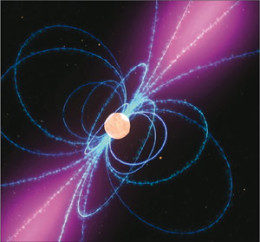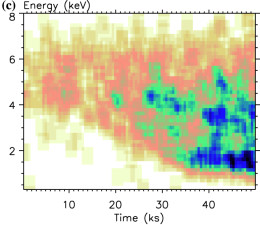Recent, unusual X-ray observations from our galactic neighbor, the Small Magellanic Cloud, have led to an interesting model for SXP 214, a pulsar in a binary star system.

Artist’s illustration of the magnetic field lines of a pulsar, a highly magnetized, rotating neutron star. [NASA]
An Intriguing Binary
An X-ray pulsar is a magnetized, rotating neutron star in a binary system with a stellar companion. Material is fed from the companion onto the neutron star, channeled by the object’s magnetic fields onto a “hotspot” that’s millions of degrees. This hotspot rotating past our line of sight is what produces the pulsations that we observe from X-ray pulsars.
Located in the Small Magellanic Cloud, SXP 214 is a transient X-ray pulsar in a binary with a Be-type star. This star is spinning so quickly that material is thrown off of it to form a circumstellar disk.
Recently, a team of authors led by JaeSub Hong (Harvard-Smithsonian Center for Astrophysics) have presented new Chandra X-ray observations of SXP 214, tracking it for 50 ks (~14 hours) in January 2013. These observations reveal some very unexpected behavior for this pulsar.
X-ray Puzzle

The energy distribution of the X-ray emission from SXP 214 over time. Dark shades or blue colors indicate high counts, and light shades or yellow colors indicate low counts. Lower-energy X-ray emission appeared only later, after about 20 ks. [Hong et al. 2016]
- SXP 214’s rotation period was measured to be 211.5 s — an increase in the spin rate since the discovery measurement of a 214-second period. Pulsars usually spin down as they lose angular momentum over time … so what caused this one to spin up?
- Its overall X-ray luminosity steadily increased over the 50 ks of observations.
- Its spectrum became gradually softer (lower energy) over time; in the first 20 ks, the spectrum only consisted of hard X-ray photons above 3 keV, but after 20 ks, softer X-ray photons below 2 keV appeared.
Hong and collaborators were then left with the task of piecing together this strange behavior into a picture of what was happening with this binary system.

The authors’ proposed model for SXP 214. Here the binary has a ~30-day orbit tilted at 15° to the circumstellar disk. The pulsar passes through the circumstellar disk of its companion once per orbit. The interval marked “A” (orange line) is suggested as the period of time corresponding to the Chandra observations in this study: just as the neutron star is emerging from the disk after passing through it. [Hong et al. 2016]
Passing Through a Disk
In the model the authors propose, the pulsar is on a ~30-day eccentric orbit that takes it through the circumstellar disk of its companion once per orbit.
In this picture, the authors’ Chandra detections must have been made just as the pulsar was emerging from the circumstellar disk. The disk had initially hidden the soft X-ray emission from the pulsar, but as the pulsar emerged, that component became brighter, causing both the overall rise in X-ray counts and the shift in the spectrum to lower energies.
Since the pulsar’s accretion is fueled by material picked up as it passes through the circumstellar disk, the accretion from a recent passage through the disk likely also caused the observed spin-up to the shorter period.
If the authors’ model is correct, this series of observations of the pulsar as it emerges from the disk provides a rare opportunity to examine what happens to X-ray emission during this passage. More observations of this intriguing system can help us learn about the properties of the disk and the emission geometry of the neutron star surface.
Citation
JaeSub Hong et al 2016 ApJ 826 4. doi:10.3847/0004-637X/826/1/4


1 Comment
Pingback: interesting model of SMC normal - pulsar binary system